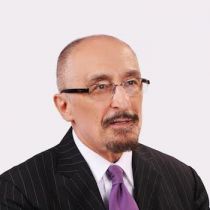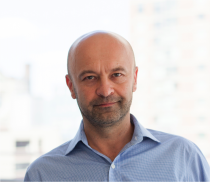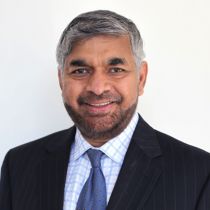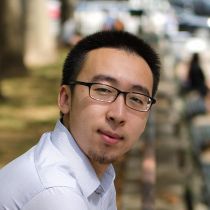Meet the New Faces of FRE
Tandon Welcomes the Newest Members of the Department of Finance and Risk Engineering
When Dr. Peter Carr joined Tandon as full professor and chair of the Department of Finance and Risk Engineering last year, the Wall Street Journal announced: “The Morgan Stanley veteran ... has headed back to school.” Now Carr — whose laurels include being named Quant of the Year by Risk Magazine and Financial Engineer of the Year by the International Association of Quantitative Finance (IAQF), receiving the Cutting Edge Research Award from Wilmott Magazine, and landing on Institutional Investor’s Tech 50 list multiple times — has recruited several other industry leaders to join him.
“There are two themes that quickly become apparent when you look at the list of our department’s newest faculty members,” he explains. “On the one hand, there are people with decades of industry experience; on the other hand, there are those who represent important emerging trends in the financial world, such as machine learning. The common thread that runs among them is that each has a desire to give back to the industry by teaching the next generation of financial professionals.”
The new professors are an integral part of Carr’s broader vision for the department, which includes a strong emphasis on redefining financial engineering, bridging the gap between theory and practice, conducting innovative research, and preparing graduates for increasingly high-tech careers.
It’s a vision that is attracting more and more students from around the world: this year applications were up by a quarter.
Carr readily shares the credit for his department’s impressive growth. “Chandrika and Ranjan Tandon’s 2015 gift to the school made my own hiring possible, and it’s making it possible for me to recruit an exceptionally strong group of new faculty members,” he stresses. “None of this would be happening without them and without the robust support of Dean Katepalli Sreenivasan.” (Carr also credits the dean for the vision to hire FRE’s first dedicated career placement director, Sara Tomeo [see below], who also hails from Morgan Stanley and who has been instrumental in efforts to both galvanize the placement function and substantially revise the curriculum.)
New FRE Faculty:
- Kevin Atteson
- Kosrow Dehnad
- Igor Halperin
- Edith Mandel
- Thomas Philips
- Sanjay Sharma
- David Shimko
- Steve Umlauf
- Zhibai Zhang
New Career Placement Director:
Kevin Atteson

If you are active in the field of bioinformatics (the use of computational techniques to analyze complex, large-scale biological data like genetic codes), Kevin Atteson’s name might just sound familiar to you, since there is a theorem in the field named in his honor. (But in case you are not, Atteson’s theorem, developed in 1999, holds that neighbor-joining — a method of creating evolutionary trees — has l∞ radius ½.)
Now the chief quant at Summer Road, the New York-based asset-management, Atteson has a strong background in computer science (with degrees from Drexel and the University of Pennsylvania), and his students, he believes, must also gain solid skills in that area. “Our finance students are lucky to have access to all of Tandon’s computer science offerings,” he says. “In our industry programming is very important. However, there is sometimes too much emphasis on writing rather than reading, code. When you learn natural language, you learn to read first but when you learn programming, you learn to write first. You must be proficient at both, because as a quant you’ll be called upon to read and modify code someone else has written.”
Atteson has held leadership posts at such big-name companies as Goldman Sachs, UBS, and Morgan Stanley, and his own start-up consultancy, founded not long after he completed a postdoctoral fellowship at Yale, ultimately grew into a 100-person firm; he expects to prepare his students for a similarly varied path. “They’ll learn skills applicable at a big bank or small company and in a wide range of industries,” he explains, noting that because of his many years in the field, he is well-equipped to give guidance on possible internships and career tracks. “We’ll use our class time to study a specific type of model — a Markov Chain, which describes a sequence of possible events in which the past and future are independent, given present circumstances — and explore its applications to finance.” He concludes, “It is a short course, but it will be very useful.”
Kosrow Dehnad

When Kosrow Dehnad entered the financial industry almost three decades ago, things were much different. “If you needed, for example, to know what soybeans were trading for, you had to subscribe to a service and get a disk or tape by mail with that information on it,” he recalled. “Now you can simply look it up yourself for free, almost in real time.” What has become important, he explains, is not the tools themselves — any new pricing model or approach will be replicated by the competition fairly quickly, and the monopoly will have a limited shelf life — but knowing how to apply the ones at your disposal on a practical basis.
He appreciates that his Tandon colleagues have such a wealth of practical experience. “Most of us have worked in the industry for years, and that’s a distinct plus for the department,” he says. “I’ve heard of schools where the people teaching risk management have never done a single trade in their lives.”
Dehnad, who has held leadership posts at such companies as Chase Manhattan, Salomon Brothers, Citibank, and the Samba Financial Group, is teaching a hands-on course on the applications of data mining. “We all have access to data now,” he says, “but the difference lies in how you use it.”
His students will be breaking into teams and choosing assets based on their analysis of the market. Although they won’t be working with actual money, Dehnad believes that you need skin in the game to be effective, and he has developed a fun system to drive enthusiasm. Student teams will make their choices on a Monday, and then on the following Monday they will check their virtual portfolios: the members of the team that posts the greatest earnings will be treated to donuts, and later, the teams that have performed best over the course of the semester will receive bonus points on their finals.
After so many years in the industry, Dehnad, the author of the well-regarded volume Quality Control, Robust Design, and the Taguchi Method (1988), feels supremely equipped to help students avoid making the mistakes so common in the academic world, where, as he says, “you can get so caught up in the elegance of the models with no relevance to real world that you end up solving problems no one actually has.” He concludes, “Upon graduation, I want students to be able to get out there in the real financial world, hit the ground running, and do as much good for their companies and clients as possible.”
Igor Halperin

Among the most promising jobs in the financial industry right now are those involving Machine Learning (ML), a subset of artificial intelligence (AI). Given the quantitative nature of finance and the amount of data generated, AI and ML lend themselves particularly well to applications in the field. “In finance we deal with numbers and data on a constant basis, and Machine Learning is very useful,” Igor Halperin says. “If someone needs a loan, algorithms can help determine if they are credit-worthy; if I, as a quantitative analyst, have to predict the earnings of a company, the likelihood of a bank closure, or some other financial event, I employ Machine Learning there as well.” He continues, “AI and its applications have become very popular in banking, trading, asset management, and other areas of Finance, as well as have been a trending topic in the media. Anyone with a solid knowledge of financial machine learning will find themselves in great demand.”
Halperin has worked in the field of finance for almost two decades, developing cutting-edge models for derivatives pricing, portfolio risk optimization, and predictive analytics for companies like Bloomberg and JPMorgan Chase. He expects the students in his Machine Learning class to gain a solid conceptual grasp of the topic, but without getting bogged down in theory. “Having a strong conceptual foundation of core Machine Learning methods, you should be able to both use them in practice and build upon this foundation to learn new methods, as needed. If you develop an ML model to tackle a practical problem at your work, you should be able to explain it succinctly to others, in an understandable way,” he asserts. He defines two key objectives of his ML class as (1) getting a solid conceptual understanding of various ML algorithms (including, in particular, very popular Deep Learning methods), and (2) getting a hands-on experience with applying these methods to real-world financial data using Python ML libraries such as scikit-learn and TensorFlow.
Halperin — who speaks Russian and Hebrew in addition to English and who holds a doctoral degree in theoretical high energy physics — explains that there is a marked difference between doing purely academic research and deploying your skills in the financial industry: in academia, it’s perfectly fine to take slow, methodical steps towards your objective, but in the real world you might not have the luxury of time. “Sometimes you will simply need to dive into a problem and start working relying on your existing foundation in ML. While your first attempt may not be very successful, or may even not work at all, it will provide you with more focused questions to google for your second attempt. The net result will be a faster learning curve,” he says. “That ability to quickly get a handle on the issue involved and come up with a solution will make you very valuable.”
Edith Mandel
Thomas Philips
Thomas Philips was working as an electrical engineer at IBM’s T.J. Watson Research Center when he realized — while working on queuing theory and the theory of random graphs — that his skills and knowledge of probability and random processes would readily transfer to the field of finance. His supervisors granted him a sabbatical from his usual duties to work at the IBM Retirement Fund, and he discovered that he had found an exciting new niche for himself.
Philips went on to a long career in the financial industry, working first as a Managing Director at a pension consultant based in Connecticut (RogersCasey), and later in senior positions in Investments and Risk Management at Paradigm Asset Management, OTA Asset Management, and BNP Paribas Asset Management.
In many instances, he was called upon to give presentations to large client groups that included major institutional investors and central banks, and found that he loved the educational aspects of those events: he had seemingly found yet another new niche, and when the chance arose to teach an interactive foundational course to Master’s students at Tandon, he eagerly accepted.
Philips, who bicycled across India as a younger man, is as comfortable discussing analog circuit design and great literature as he is discussing valuations and the expected return of the market, and is dedicated to expanding his horizons. “The same math that I applied to monitor portfolios and to rapidly detect underperformance has been used, for example, by pediatric cardiologists to monitor surgical outcomes and rapidly detect surgical errors,” he says, explaining the multidisciplinary character of financial engineering. “You need to be open minded and a bit of a polymath to succeed in this field. You are not going to be able to manage assets wisely if you don’t have a good understanding both of history and of current events in addition to probability, statistics, and portfolio optimization. In particular, you must not ever assume that finance is just a matter of substituting numbers into equations, or fall into the trap of blindly trusting a mathematical model. The world is far too complex for its vagaries to be captured in an equation.”
Sanjay Sharma

It is universally acknowledged that Brooklyn is currently among the most exciting and colorful places on the planet, and it seems especially fitting that it is now part of Sanjay Sharma’s novel-worthy life journey. The founder and chairman of GreenPoint Global — which provides content, process, and technology solutions and services to a wide variety of clients, including publishers, insurers, law firms, banks, and schools – Sharma spent his early years in New Delhi, where he attended a school so short of resources that its classrooms were often housed in tents. Despite those modest circumstances, he discovered a love of learning that eventually took him to St. Stephen’s College, widely known as the Oxford of India.
There he learned English and studied physics and marine engineering before spending seven years on the high seas as a merchant marine officer. “I discovered that the concept of risk is relative,” he says. “In the finance industry, a mistake will cost money, but when you are working with massive and complex tankers and cargo ships, a mistake can cost your life.”
Once upon dry land again, Sharma’s next adventure took him to the Wharton School of Business, where he was awarded a graduate fellowship and earned an MBA. In finance, he had found his next niche. His career in the industry has now spanned more than two decades, with investment banking and risk management posts at such big-name companies as Goldman Sachs, Merrill Lynch, Citigroup, and Moody’s. He never lost his appetite for education, however, and although it took a decade of part-time study, in 2001 he earned a doctoral degree from NYU Stern.
That same appetite led him to posts in academia, and he has served as a visiting professor at the EDHEC Business School in France and as co-director of the Hass Fellowship Program at the University of California, Berkeley. He was also moved to launch Tomorrow’s Genius, a company that provides core, supplemental, and test-prep materials to schools, organizations and communities serving middle- and high-school students, with a focus on underserved populations in New York City.
Sharma, the author of the 2013 book Risk Transparency and the forthcoming volume The Fundamental Review of Trading Book: Impact and Implementation, is excited to be at Tandon, where he’s teaching a project-based capstone course. “I’ve had many years of recruiting recent graduates, and they often have only theoretical knowledge,” he explains. “I want my Tandon students to deal with practical applications right away — almost as though they were already employed.”
David Shimko
David Shimko’s career has included stints in both the financial industry and academia. “Academia teaches you to be rigorous,” he says, “and industry teaches you to be relevant.”
Before coming to Tandon, where he is now a full industry professor, Shimko held posts at such iconic companies as JPMorgan, where he was VP and Head of Commodity Derivatives & Credit Risk Management Research, and Bankers Trust, where his titles included Principal and Head of Risk Management Advisory. He also co-founded his own independent risk management consulting firm, Risk Capital; presided over Asset Deployment LLC, a company that was issued multiple patents for products that enhanced returns on illiquid assets; served as president and CEO of CreditCircle, a startup dedicated to providing low cost borrowing by using social networks to evaluate a person's credit-worthiness rather than numerical algorithms; and was named director of Novantas, which provides analytic advisory services and technology solutions to global financial institutions.
Add to that teaching duties at the University of Southern California and Harvard Business School, and Shimko has a keen eye for what students need to learn in order to be a success in the workforce. An engineering school, he asserts, is a stellar proving ground.
“Engineers are trained like applied scientists,” he explains. “They embrace the rigor of the scientist’s research but also know how to apply the research to find actionable solutions to real problems. That’s important because when you’re working for an employer, you actually need to be able to value a contract or a company, not merely opine on some theory of valuation.”
As the financial industry evolves, Shimko says, Tandon’s Department of Finance and Risk Engineering is keeping pace. “It’s not enough to be generalist these days,” he declares. “There is a lessening need for traditional MBAs and more of a need for corporate finance programs like ours, which are taught in a totally different way: quantitative, computational, data-oriented, and very much applied on a practical level.”
His students will gain an innate understanding of risk and its importance in the corporate decision-making process and will be equipped to work in a variety of settings, including banks, trading companies, and nonfinancial corporations. “Here at an engineering school, they’re not afraid of coding or differential equations,” he says, “and that will make them very valuable out in the industry.”
Steve Umlauf
Steve Umlauf thinks that it is important for students to see things from the point of view of a practitioner: what will they need to know once they are actually working out in the field?
“I teach an introduction to corporate finance,” he explains, “and I want students to understand financial analytics, how to raise money, how to value securities, and other topics like that. It’s a very applications-focused course.”
Umlauf, who earned his doctoral degree from MIT, has held high-level posts at such big-name companies as Morgan Stanley, where he served in a variety of senior capital markets and risk roles, and AIG, where as Head of Analytics his responsibilities included asset and derivatives modeling, portfolio and risk analytics, performance measurement and CCAR investment portfolio projections. In early 2017 he joined Citi, assuming the role of Head of Model Risk Management and member of the Risk Management Executive Committee. In that capacity, he is charged with establishing and overseeing a firm-wide approach to Model Risk Management, developing and executing the overall strategy of the group, and driving the implementation of Citi’s enhanced Model Governance and Model Risk Management Framework, while ensuring quality execution of the Firm’s regulatory Commitments.
His time at Tandon marks something of a return to academic roots; before embarking on his long career in the financial services industry, he was an assistant professor of finance at London Business School and the author of academic articles in the Journal of Finance and the Journal of Financial Economics.
His varied background makes him a valuable resource in a program aimed at bridging the gap between academia and industry. “In every position, a financial professional will be tasked with solving real-world problems,” he says, “and students need to be prepared for that.”
Zhibai Zhang

Zhibai Zhang is excited to be teaching at an engineering school. “It’s a great opportunity for students to dive right into machine learning and big data,” he says. “And those have become very hot topics in our field in recent years.” Zhang’s course, which will explore the foundation and practical applications of machine learning in the financial industry, will require that willingness to take the plunge into what might, for them, be uncharted waters. “It will be very challenging, but also very exciting,” he says.
Zhang, a Vice President, Quantitative Researcher at a leading asset management firm, explains that “quants” have always used the most modern mathematical theories at their disposal to analyze signals and construct financial models. And machine learning has emerged to become one of the most powerful tools in this arena. “We live in a world in which more and more data is available to us,” he says. “There’s nothing like machine learning that can provide such informative interpretation of big data.”
Zhang holds a B.S. in Mathematics from Zhejiang University and a Ph.D. in Theoretical Physics from the City University of New York. During his doctoral studies, he applied high-performance computing techniques to compute high-energy particle scattering cross-sections, which are used in experiments at the Large Hadron Collider. Later, after extending his research to machine learning and finance, Zhang has found himself taking great advantage of his rigorous training in theoretical physics. He has since been conducting quantitative finance research in both industrial and academic settings.
Zhang has taught algebra- and calculus-based physics courses (including mechanics, thermodynamics, and fluid dynamics) at the NYC College of Technology, part of the CUNY system, and understands the importance of addressing the basics of any topic. “I’ll cover as much ground as possible,” he says, “while exploring new tools and new methods of analysis. I want my students to be as well-prepared for the work world as possible.”





